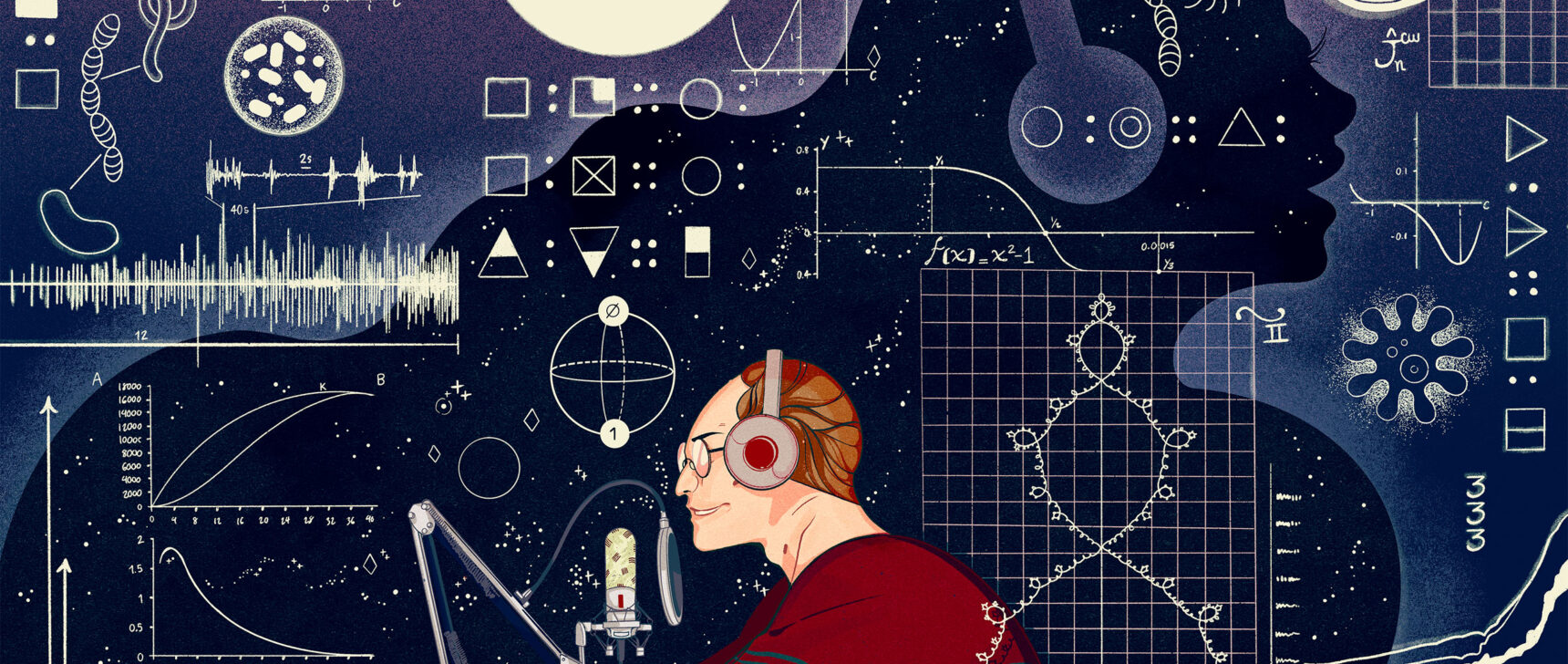How Radio Astronomy Reveals the Universe
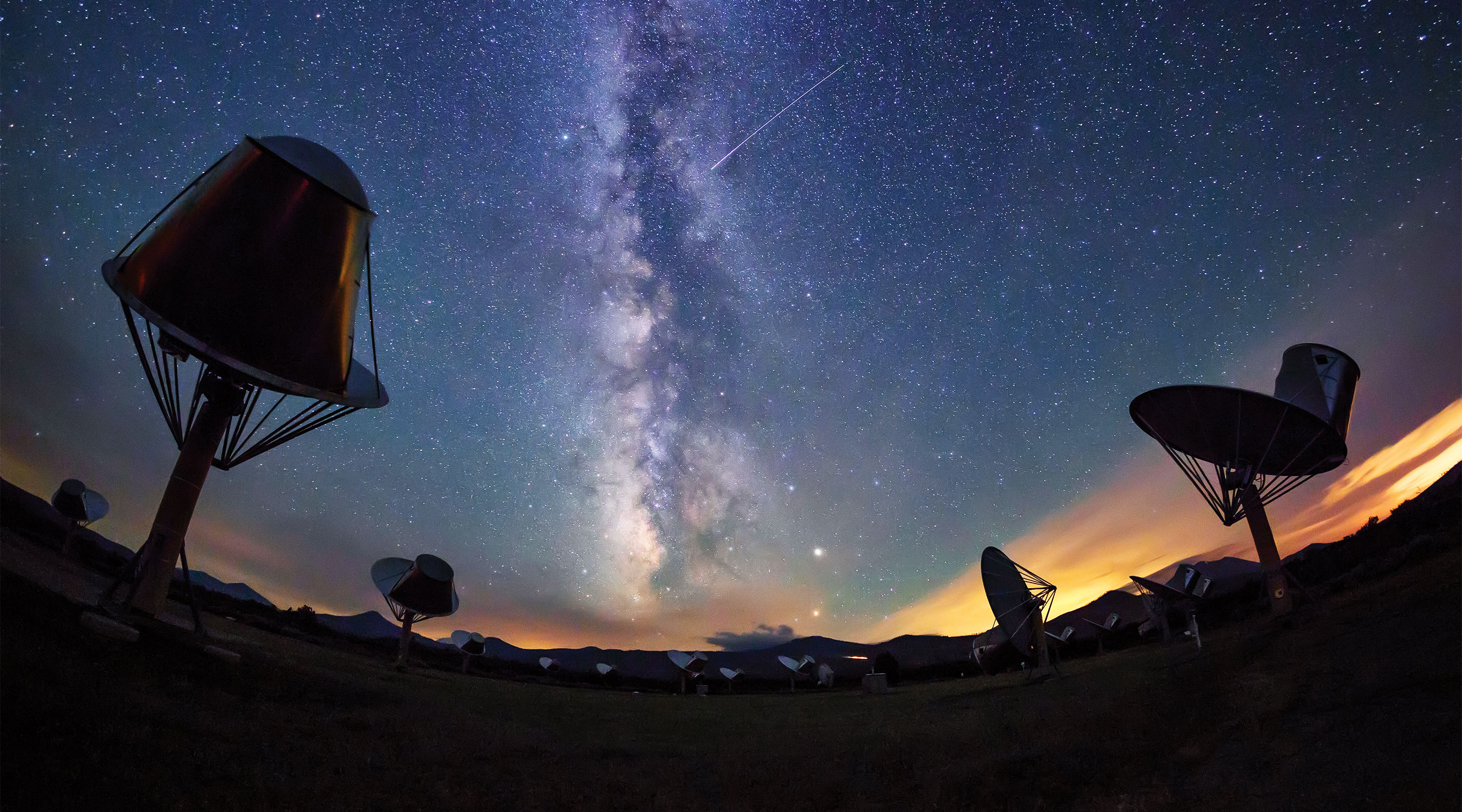
The Milky Way shines above the Allen Telescope Array in California.
Introduction
If you ask an astronomer to choose the single most exciting picture in all of astronomy, many of us will point to a familiar orange ring. At a glance it may not look like much — a fuzzy glowing doughnut, bulging slightly at the bottom and, as of last month, streaked with curving lines — but in reality this unassuming circle is humanity’s first glimpse of a black hole, with the colors chosen not to mimic realism, but to indicate the intensity of radio emissions.
Captured in a picture so sharp that it was like reading the date on a quarter in Los Angeles while standing in Washington, D.C., the image revealed a black hole 6.5 billion times more massive than our own sun at the heart of a galaxy 55 million light-years away. The tiny details of the picture have revealed that the black hole is spinning clockwise and consuming the equivalent of hundreds of Earth masses every year. Even the newly hewn lines represent telltale signatures of a strong magnetic field.
This unprecedented picture of one of the most mysterious objects in all of physics is the latest in a long line of discoveries made possible by radio astronomy. The science contained in the famous image may be mind-blowing, but the science that made it possible is impressive in its own right, allowing researchers working in concert across the planet an entirely new way to study the cosmos.
The radio regime lies at one extreme of the electromagnetic spectrum, where light waves have low energies. The first detected radio waves, produced by the acceleration of charged particles, were generated artificially in the late 1800s. Easy to make, with long wavelengths that allowed them to travel great distances unperturbed, radio waves were immediately seen as an excellent communication tool. By the early 20th century, physicists knew the waves could also be produced by natural phenomena, like lightning, but they mainly wanted to avoid these pesky sources of “noise” to improve the clarity, power and reach of radio communication technology.
Karl Jansky was working on precisely this goal when he first discovered “star noise” by accident in 1931. As a physicist and engineer at Bell Labs, he designed an enormous antenna 100 feet across and 20 feet tall mounted on a set of Model T tires so it could spin and point in any direction. His colleagues nicknamed the contraption “Jansky’s merry-go-round.”
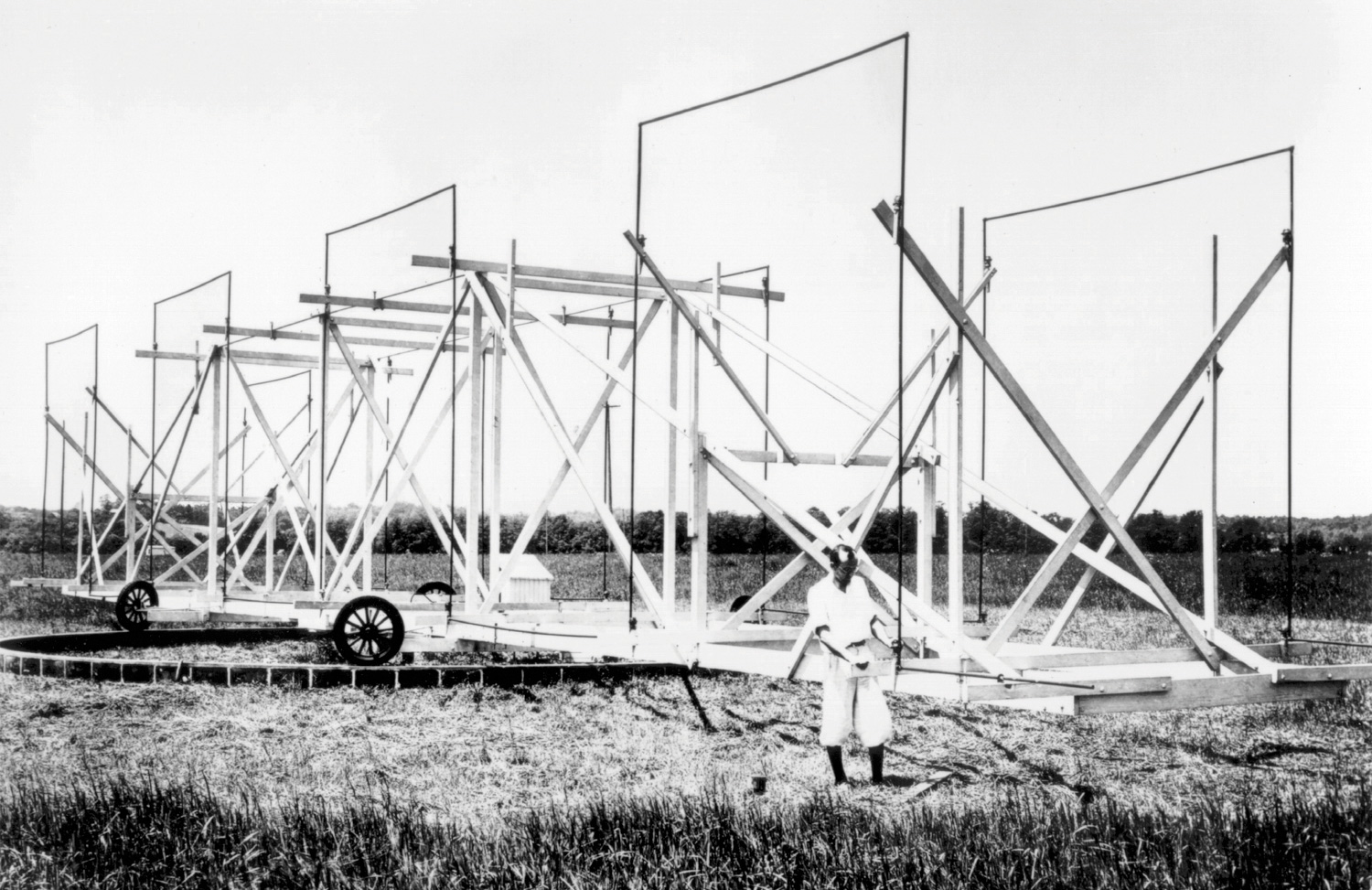
Karl Jansky discovered cosmic radio signals by accident, using a spinning antenna nicknamed “Jansky’s merry-go-round.”
When Jansky began using the antenna, he noticed a faint but constant hiss in his data. Taking advantage of the merry-go-round’s maneuverability, he tracked the source and eventually pinpointed its location. The antenna wasn’t picking up nearby thunderstorms or stray sources of Earth-bound radiation — it was detecting energy coming from the center of the Milky Way.
Jansky’s discovery was mostly met with mild curiosity by the astronomy community. In the midst of the Great Depression, observatories weren’t willing to put their limited funds toward speculative new technology. But a young scientist and engineer named Grote Reber found Jansky’s discovery fascinating and vowed to devote his career to studying radio signals from space. After getting turned down for a job at Bell Labs, he decided to build his own radio telescope in his Illinois backyard: a parabolic 31-foot dish with a radio receiver mounted directly above it.
His efforts were wildly successful, reproducing Jansky’s observations and then creating the first radio map of the sky. He found spots of bright radio emission that would later be identified as distant galaxies and the detritus left behind by recent supernovas. By 1940, Reber was publishing in The Astrophysical Journal, and his work seeded a broader interest in radio observations among the astronomical community.
Observing these longer wavelengths gave astronomers an entirely new window into the universe, allowing them to detect radio emission produced by the glow of faint faraway heat sources and exotic physics capable of accelerating charged particles in extreme and unexpected ways. Radio telescopes were the first to spot the rapidly spinning compact remnants of dead massive stars known as pulsars, the cosmic microwave background (light bearing the fingerprints of the Big Bang itself), and the first signs of supermassive black holes at the centers of galaxies including our own — the suspected source of Jansky’s original discovery. These phenomena are simply invisible if you only look at visible light.
The science of radio astronomy is thrilling, but the telescopes look decidedly odd to anyone accustomed to the shiny mirrored telescopes they’ve peered through. However, at the long wavelengths of radio light, the dishes of radio telescopes are shiny too, reflecting radio waves from the sky up to a receiver, just as visible light reflects off a telescope’s mirror and into an eyepiece. Radio telescopes also follow the same fundamental tenets of visible-light telescopes: The most effective ones should go someplace dark (to eliminate competing sources of light), and the bigger the better.
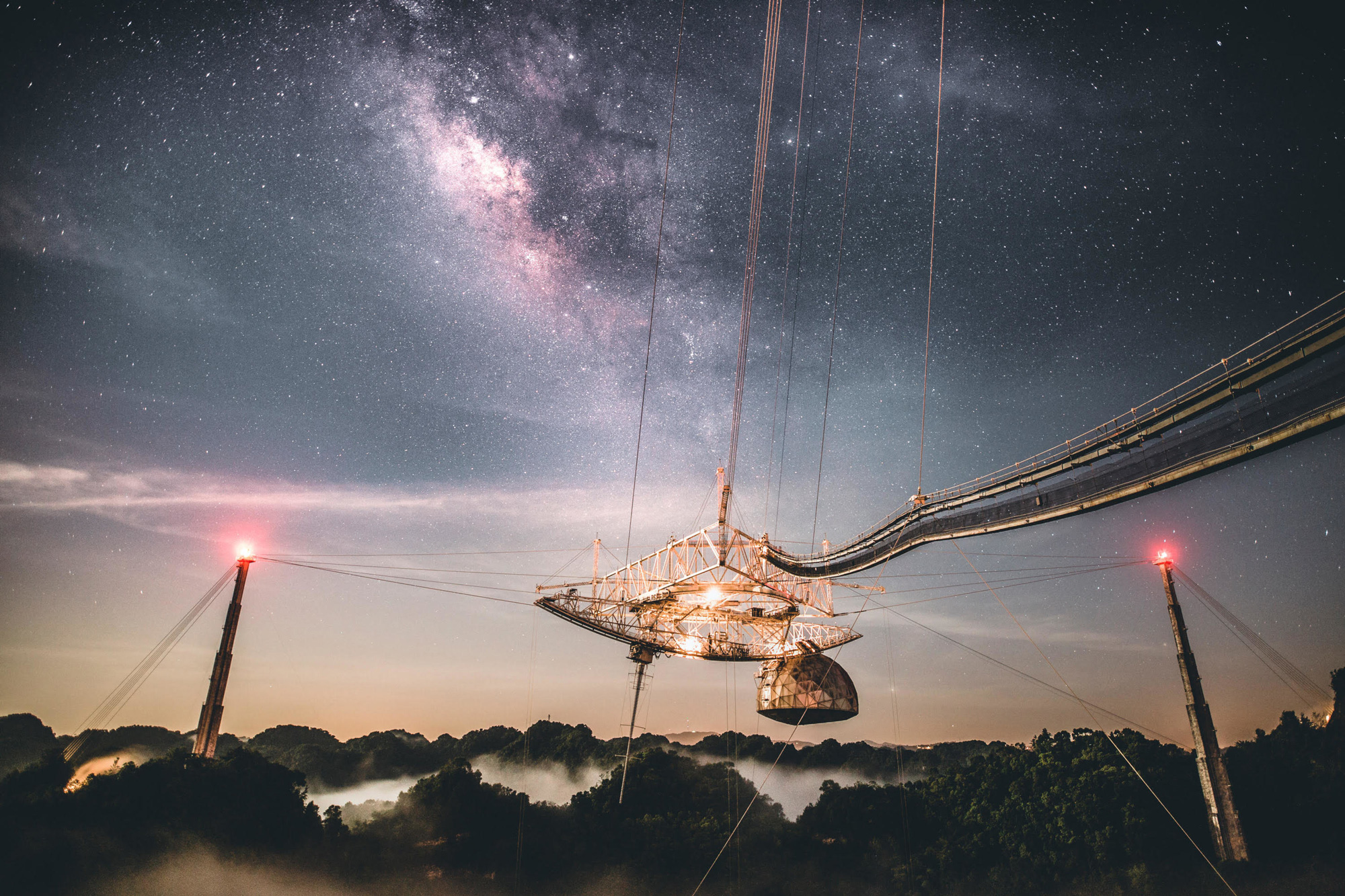
The Arecibo Observatory in Puerto Rico was home to one of the biggest radio telescopes in the world, until its collapse in 2020.
While a large telescope area lets us collect more light and observe fainter objects (think of your pupils dilating in a dark room), a large telescope diameter helps us take sharper pictures (think of the huge telephoto lenses used by sports photographers to capture crisp action photos from stadium sidelines). This sharpness is often a key goal in astronomy, as it allows us to pinpoint individual stars in faraway galaxies or map the precise shape of a nebula, and the long wavelengths of radio astronomy offer a different way of building big telescopes. Radio telescopes can achieve incredibly large effective diameters thanks to a technique known as interferometry, which combines data from an array of smaller individual dishes, enabling them to act as one gigantic telescope that produces a single sharp image. The science of interferometry is daunting, but it produces incredible results: It was this very technique that allowed the Event Horizon Telescope to meld eight radio observatories from around the world into a single planet-size telescope and capture its famous picture of a black hole.
So “big” is clearly possible for radio telescopes. What about “dark”? That poses a much greater challenge. Ironically, Jansky’s original goal — to filter out natural sources of radio waves and make way for communication technology — is now reversed for radio astronomers trying to study the universe in the age of modern electronics. If your eyes could see in radio light, the room around you would become a blinding tangle of radio signals: a cloud of Wi-Fi networks, sporadic bursts of light from nearby cell phones, even blinks from the tiny lightning bolts generated by spark plugs in passing cars.
One way to prevent this chaos from overwhelming cosmic data is to limit nearby artificial radio signals, as the Green Bank Observatory in West Virginia does. This facility sits deep in the National Radio Quiet Zone, which restricts technology to minimize radio noise: Wi-Fi, cell phones and microwaves are banned, and all vehicles run on diesel engines. (Even so, researchers here once lost observing time to noise from, of all things, flying squirrels, after a nearby conservation study fit the rodents with GPS collars to study their migration habits.) The individual observatories that make up the Event Horizon Telescope may be scattered across the globe, but each location — from the South Pole to the Atacama Desert to the highest mountain in Hawai‘i — is decidedly remote, as isolated as possible from humanity’s ever-encroaching noise.
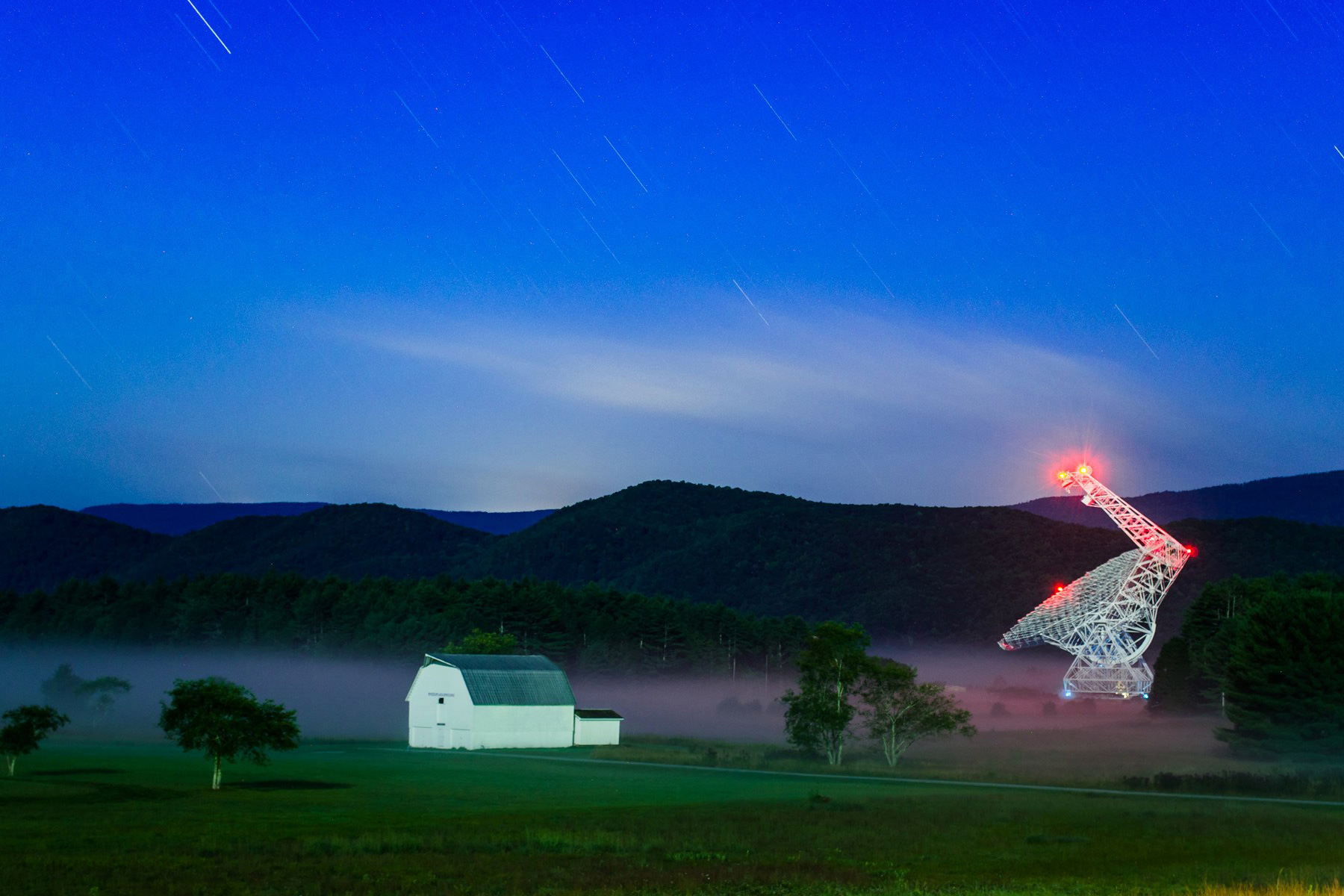
The Green Bank Telescope in West Virginia lies within the National Radio Quiet Zone, which prohibits the use of certain devices so they don’t interfere with radio signals from space.
Brett McGuire
As frustrating as it is that new technology can increase the proliferation of radio noise, it also raises a tantalizing possibility: Might we someday observe artificial radio waves not of our own making?
Radio astronomy has long been considered a great way to search for signals from other worlds. In fact, the very first radio astronomy experiment can be traced back before Jansky to August of 1924, when Mars made its closest pass to Earth in nearly a century. Astronomers in the United States advertised a “National Radio Silence Day,” encouraging people to cease using radios at regular intervals in the hopes that a signal from neighboring Martians might make it through. The United States Naval Observatory even sent a radio receiver aloft on a dirigible to pick up a potential Martian message, with a cryptographer on hand in case translations were needed.
Today the search for extraterrestrial intelligence, or SETI, is a serious scientific endeavor. Spearheaded by renowned scientists like Frank Drake and Jill Tarter, and using hard-won facilities like the Allen Telescope Array in California, SETI researchers embrace the exciting possibilities for discovery offered by the radio regime. After all, the same radio waves used for long-distance communication here on Earth also travel outward, broadcasting telltale signs of our technological prowess into the cosmos. It’s entirely possible that distant civilizations could be sending out similar signals, or even trying to transmit messages on purpose, since they’ll be dealing with the same electromagnetic spectrum that we are.
Clearly, radio astronomy offers us immense possibilities: the ability to see the unseeable in a faraway black hole, to unravel exciting new physics, and potentially even to find our first evidence of extraterrestrial intelligence. Funny as they might look to the uninitiated, radio telescopes are an invaluable tool of astronomy, and one that will continue to reveal new parts of the universe for us to explore.



